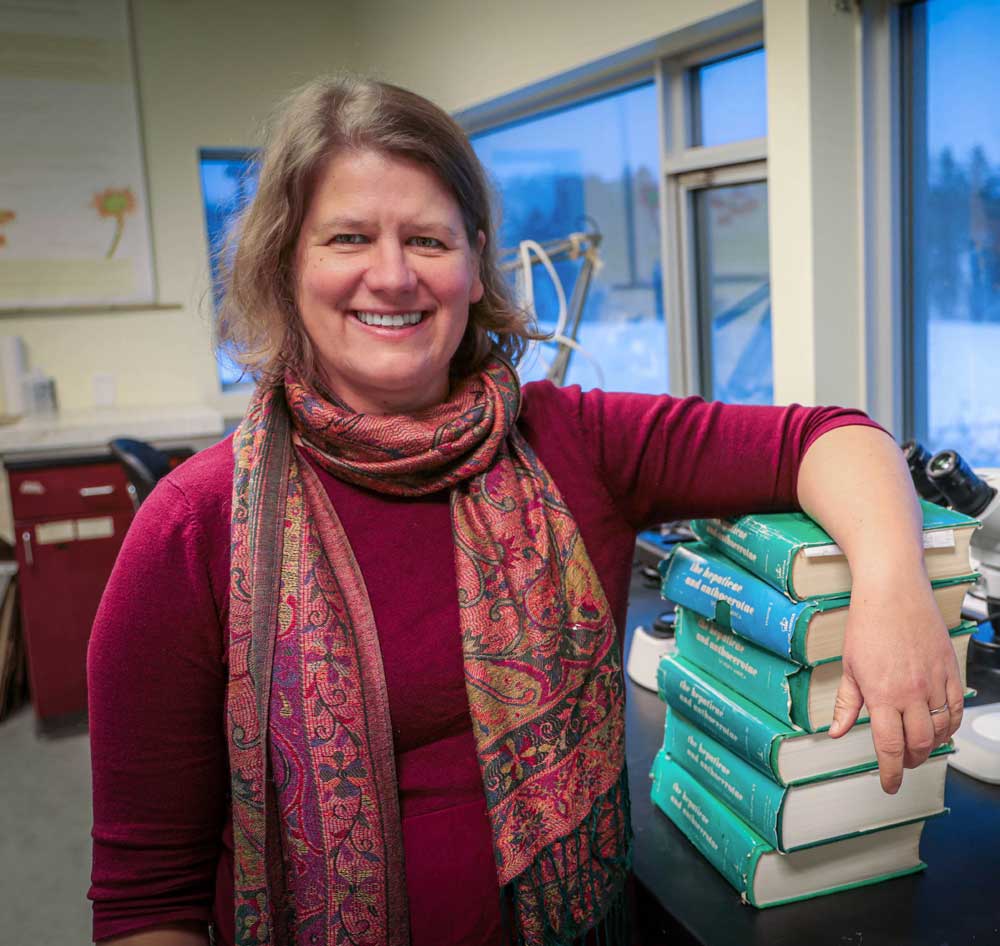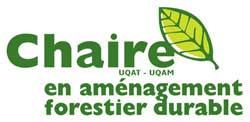
Nicole Fenton œuvrent à la Chaire en aménagement forestier durable depuis 2003, comme étudiante, stagiaire postdoctorale, chargée de projet et maintenant professeur-chercheure sous-octroi. Nicole Fenton à quitter ses prairies et forêts boréales natales (BSc. Biologie University of Winnipeg 1998) pour l’exotique Baie de Fundy en Nouveau-Brunswick (M.Sc. biologie, Université du Nouveau-Brunswick à Saint-John 2001). Pendant son séjour sur la côte Est, elle a développé sa spécialité, les bryophytes, sous la direction de Kate Frego. Après cinq ans sans un vrai hiver, elle a déménagé en Abitibi pour retrouver la neige et le froid. Maintenant professeur sous-octroi à l’IRF elle est contente de continuer de travailler avec la Chaire AFD. Avec Osvaldo Valeria, elle est également responsable du transfert technologique.
Elle a obtenu un doctorat en Sciences de l'Environnement à l'UQAT sous la direction d'Yves Bergeron. Son sujet de thèse portait sur la compétition entre les mousses hypnacées et les sphaignes dans le contexte de l'entourbement des peuplements forestiers de la pessière à mousse.
Elle est également titulaire de la CHAIRE INDUSTRIELLE CRSNG-UQAT SUR LA BIODIVERSITÉ EN CONTEXTE MINIER
En 2023, Nicole a été lauréate du prix Richard Spruce de l'Association Internationale de Bryologie. Le Prix est destiné à récompenser un membre de l'AIB ayant apporté une contribution importante à la bryologie au cours des 25 premières années de sa carrière (à compter de sa première publication en bryologie).
THÈMES DE RECHERCHE
Fonctions écosystèmiques de bryophytes
Les bryophytes sont omniprésentes dans le milieu boréal, et peuvent grandement influencer les fonctions écosystèmiques (p.ex. cycle d’éléments nutritifs, et de l’eau) des systèmes boréaux. Par contre, nos connaissances sur ces impacts sont naissante, et leurs implications dans l’aménagement forestier est encore moins connu. La docteure Fenton mène des projets de recherche qui vont permettre de mieux comprendre le rôle des bryophytes dans les processus des écosystèmes boréaux, et de prédire comment leurs impacts interagissent avec nos aménagements.
L’écologie des bryophytes en paysages naturels et aménagés
Nos connaissances sur l’écologie des bryophytes forestières en Amérique du Nord est encore en développement. La docteure Fenton œuvre dans ce domaine pour bien comprendre les dynamiques des communautés dans des milieux une variété de milieux, autant au niveau du site ou peuplement qu’au niveau du paysage.
Étudiant(e)s de maîtrise et doctorat recherché(e)s
Je suis toujours ouverts à des étudiant(e)s motivé(e)s et passionné(e)s, contacter moi pour les détails sur les projets en cours.
Formation académique
- Postdoctorat UQAM-UQAT
- Ph.D. UQAT, 2006
- M.Sc. Biologie Université du Nouveau-Brunswick, Saint-John, 2001
- BSc. Biologie Université de Winnipeg, 1998
Les tourbières : toute une histoire
Le podcast "Les tourbières : toute une histoire" est la prolongation d'une exposition mêlant art et vulgarisation scientifique. Le projet initial, "Atlas de biodiversité : les milieux humides" a pour but de vulgariser les données de la recherche produite à l'Université du Québec en Abitibi-Témiscamingue (UQAT, Québec). Les tourbières sont d'importants écosystèmes qui abritent une grande biodiversité, et qui sont indispensables pour le stockage du carbone à l'échelle planétaire. C'est une invitation à venir découvrir les trésors de la nature, et les merveilleuses espèces vivantes qui se cachent dans nos tourbières.
Aujourd'hui, c'est à la Professeure Nicole Fenton de prendre la parole et de nous dévoiler les coulisses du projet “Atlas de biodiversité : les milieux humides”. Comment est né le projet ? Qui sont les étudiant.e.s qui travaillent dessus ? Quel est l'intérêt d'un tel projet ? Les réponses à ces questions et bien d'autres te seront donné dans cet épisode.Bonne écoute!
Autres sites à consulter :
Centre d'étude de la forêt (CEF) ResearchGate Nesrine Tlili, Nicole J. Fenton, Christine Martineau. Les mousses et leur symbiose bactérienne jouent une nouvelle partition : adaptation face à la poussière minière. 2025. Le Couvert Boréal 44
Sudha Ghimire, Nicole J. Fenton, Osvaldo Valeria. Comment les feux de forêt et la récolte façonnent-ils les communautés végétales du sous-bois? 2025. Le Couvert Boréal 8
Félix Gery, Marc-André Lemay, Annie DesRochers, Nicole J. Fenton, Miguel Montoro Girona, Peter Ryser, Vincent Poirier, Fabio Gennaretti. A restoration strategy to promote tree establishment in mining-polluted rocky outcrops using bryophytes 2025. Restor. Ecol. e70196
DOI : 10.1111/rec.70196
Ange-Marie Botroh, David Paré, Xavier Cavard, Nicole J. Fenton, Kelly Ann Bona, Yves Bergeron. Forest type drives the response of boreal forested peatlands to wildfire: a simulation study 2025. Can. J. For. Res. 1
DOI : 10.1139/cjfr-2024-0301
Mélanie Nicoletti, Yves Bergeron, Nicole J. Fenton, Tadeusz Bartek Splawinski, Pascale Bélanger-Lavallée. Eastern white pine and red pine forest regeneration following secondary disturbance 2025. For. Ecol. Manage. 122864
DOI : 10.1016/j.foreco.2025.122864
Elsa Dejoie, Marc-André Lemay, Nicole J. Fenton, Annie DesRochers, Joëlle Marion, Martine M. Savard, Trevor J. Porter, Daniel Proulx, Fabio Gennaretti. Spatiotemporal assessment of lead (Pb) and cadmium (Cd) contamination in urban tree rings near an industrial smelter: high intraspecific variability but limited spatial differentiation. 2025. Atmospheric Pollution Research 102582
DOI : 10.1016/j.apr.2025.102582
Laima Liulevičius, Nicole J. Fenton. Résurrection dans l'Arctique 2025. Le Couvert Boréal 39
Mialintsoa Aroniaina Randriamananjara, Nicole J. Fenton, Annie DesRochers. Understory vegetation diversity and composition in intensively managed plantations compared to extensively managed forests 2024. New Forests 5
DOI : 10.1007/s11056-024-10071-9
Geofroy Zanin, Annie DesRochers, Nicole J. Fenton. Des friches agricoles aux peupliers hybrides, peut-on accroitre la production de bois sans nuire à la biodiversité végétale? 2024. Le Couvert Boréal 42
Éliane Grant, Nicole J. Fenton, Hugo Asselin. Les milieux humides : un élément central de la relation entre les Autochtones et l’orignal 2024. Le Couvert Boréal 10
DOCTORANT
MAîTRISE
STAGIAIRE
Je n'ai aucune offre de projet pour le moment mais je recrute régulièrement de nouveaux étudiants de maîtrise et de doctorat. Je suis professeur habilité à diriger des étudiant(e)s au programme réseau de doctorat en sciences de l'environnement du réseau UQ. N'hésitez pas à me faire parvenir votre CV ainsi qu'une lettre de motivation.
1-11. Dispersion des bryophytes: rôles des traits fonctionnels.
1-12. Effet des perturbations multiples sur la communauté de sous-bois.
1-13. Effets de la fonderie Horne sur les communautés végétales des affleureurements rocheux.
2-11. Identifier la qualité d’habitat des forêts anciennes boréales à l’aide du LiDAR aéroporté
2-15. Distribution de la diversité végétale dans les milieux humides d'Abitibi.
3-27. Le rôle des bryophytes dans l'atténuation de l'effet du gel sur les processus du sol.
4-02. Chaire de recherche industrielle CRSNG en sylviculture et production de bois
4-03. Revégétalisation d'affleurements rocheux
5-05. Caractérisation fonctionnel des milieux humides de l’Abitibi.
2-11. L'importance des habitats rares pour la diversité végétale régionale en Abitibi
2-13. Identifier la qualité d’habitat des forêts anciennes boréales à l’aide du LiDAR aéroporté
4-02. Chaire de recherche industrielle CRSNG en sylviculture et production de bois
5-06. Caractérisation fonctionnel des milieux humides de l’Abitibi.
Mélanie Nicoletti, Nicole J. Fenton, Yves Bergeron. La coupe progressive est-elle capable de régénérer les peuplements de pin blanc de l’Est et de pin rouge à l’image des feux de surface ? Pourquoi ? 26e colloque de la Chaire AFD. Hôtel Forestel, Val-d'Or, Québec. (2024-11-20)
Elsa Dejoie, Marc-André Lemay, Nicole J. Fenton, Annie DesRochers, Joëlle Marion, Martine Savard, Fabio Gennaretti. Les cernes d’arbres comme bioindicateur de la pollution au plomb et au cadmium : le cas des arbres urbains de Rouyn-Noranda 26e colloque de la Chaire AFD. Hôtel Forestel, Val-d'Or, Québec. (2024-11-20)
Geoffrey Zanin, Annie DesRochers, Nicole J. Fenton. Reboisement de terres agricoles par du peuplier hybride et ses conséquences sur la diversité et la composition des communautés végétales 17e colloque annuel du CEF, Université du Québec en Outaouais (2024-05-03)
Elsa Dejoie, Fabio Gennaretti, Nicole J. Fenton, Annie DesRochers, Martine Savard, Trevor Porter. Les cernes d'arbres comme bioindicateur de la pollution au plomb et au cadmium : le cas des arbres urbains de Rouyn-Noranda 17e colloque annuel du CEF, Université du Québec en Outaouais (2024-05-03)
Joël Masimo Kabuanga, Nicole J. Fenton, Osvaldo Valeria. Détection des principaux métaux lourds sur les affleurements rocheux autour de la fonderie de Rouyn-Noranda, Québec à l'aide de la télédétection à haute résolution spatiale 17e colloque annuel du CEF, Université du Québec en Outaouais (2024-05-02)
Bandana Subedi, Nicole J. Fenton, Xavier Cavard. The role of bryophytes in buffering the impacts of climate change-induced decline of snow cover on belowground forest carbon dynamics in boreal forest ecosystems 17e colloque annuel du CEF, Université du Québec en Outaouais (2024-05-02)
Alphonse Nyandwi, Osvaldo Valeria, Nicole J. Fenton. Building and validating unsupervised wetland classification method based on remote sensing data at very high-resolution for the Abitibi region 17e colloque annuel du CEF, Université du Québec en Outaouais (2024-05-02)
Mialintsoa Aroniaina Randriamananjara, Nicole J. Fenton, Annie DesRochers. Plantations versus forêts naturellement régénérées et plantées: quelles réponses de la biodiversité de la végétation de sous-bois? 17e colloque annuel du CEF, Université du Québec en Outaouais (2024-05-02)
Fatimata Niang, Philippe Marchand, Nicole J. Fenton, Bienvenu Sambou, Élise Bouchard. Utilisation des traits fonctionnels pour prédire la présence d'espèces de valeur dans les forêts aménagées du domaine soudanien du Sénégal, Afrique de l'ouest 17e colloque annuel du CEF, Université du Québec en Outaouais (2024-05-02)
Angana Kuri, Nicole J. Fenton, Mebarek Lamara, Xavier Cavard. Gradient-based assessment of ecosystem resilience: evaluating vegetation, soil microbiome diversity and carbon pools of outcrops in proximity to the Horne Smelter of Rouyn-Noranda 17e colloque annuel du CEF, Université du Québec en Outaouais (2024-05-02)
Mélanie Nicoletti, Yves Bergeron, Nicole J. Fenton. S'inspirer des perturbations naturelles pour aménager la forêt : cas des pins blancs et rouges du Témiscaming et Nipissing 17e colloque annuel du CEF, Université du Québec en Outaouais (2024-05-02)
Sudha Ghimire, Nicole J. Fenton, Osvaldo Valeria. Identifying the effects of multiple disturbances and their interaction on understorey plant communities in the boreal forest 17e colloque annuel du CEF, Université du Québec en Outaouais (2024-05-02)
Mialintsoa Aroniaina Randriamananjara, Nicole J. Fenton, Annie DesRochers. Les plantations utilisant des peupliers hybrides réduisent-elles la biodiversité de la végétation de sous-bois par rapport à des forêts régénérées naturellement et des plantations d'espèces indigènes après une coupe forestière ? 25e colloque de la Chaire AFD. Université du Québec en Abitibi-Témiscamingue, Rouyn-Noranda, Québec. (2023-11-28) youtube
Félix Gery, Annie DesRochers, Nicole J. Fenton, Fabio Gennaretti. Usage de mousses dans une stratégie de revégétation d'affleurements rocheux dégradés par les activités minières. 25e colloque de la Chaire AFD. Université du Québec en Abitibi-Témiscamingue, Rouyn-Noranda, Québec. (2023-11-28) youtube
Sudha Ghimire, Nicole J. Fenton, Osvaldo Valeria. Understanding the cumulative effect of multiple disturbances and their interaction on understorey plant communities in the boreal forest 25e colloque de la Chaire AFD. Université du Québec en Abitibi-Témiscamingue, Rouyn-Noranda, Québec. (2023-11-28)
Bandana Subedi, Nicole J. Fenton, Xavier Cavard. The role of bryophytes in buffering the impacts of climate change-induced loss of snow cover on belowground forest carbon dynamics. 25e colloque de la Chaire AFD. Université du Québec en Abitibi-Témiscamingue, Rouyn-Noranda, Québec. (2023-11-28)
Elsa Dejoie, Nicole J. Fenton, Annie DesRochers, Fabio Gennaretti. Etude spatio-temporelle du plomb et du cadmium dans les cernes d’arbres aux alentours de Rouyn-Noranda 25e colloque de la Chaire AFD. Université du Québec en Abitibi-Témiscamingue, Rouyn-Noranda, Québec. (2023-11-28)
Alphonse Nyandwi, Osvaldo Valeria, Nicole J. Fenton. The diversity of plants between different classes of wetlands in two contrasting regions, Abitibi and Témiscamingue 25e colloque de la Chaire AFD. Université du Québec en Abitibi-Témiscamingue, Rouyn-Noranda, Québec. (2023-11-28)
Joël Masimo Kabuanga, Nicole J. Fenton, Osvaldo Valeria. Caractérisation de la distribution spatiale de la végétation de la zone d’influence de la fonderie par télédétection et détermination de la valeur biologique ou sociale 25e colloque de la Chaire AFD. Université du Québec en Abitibi-Témiscamingue, Rouyn-Noranda, Québec. (2023-11-28)
Maxime Thomas, Yan Boulanger, Hugo Asselin, Mebarek Lamara, Nicole J. Fenton. Comment les changements climatiques et l'exploitation forestière influenceront-ils la présence de deux plantes d’importance culturelle ? 3e rencontre annuelle du Laboratoire International de Recherche sur les Forêts Froides. Station touristique Duchesnay, Québec. (2023-10-04)
